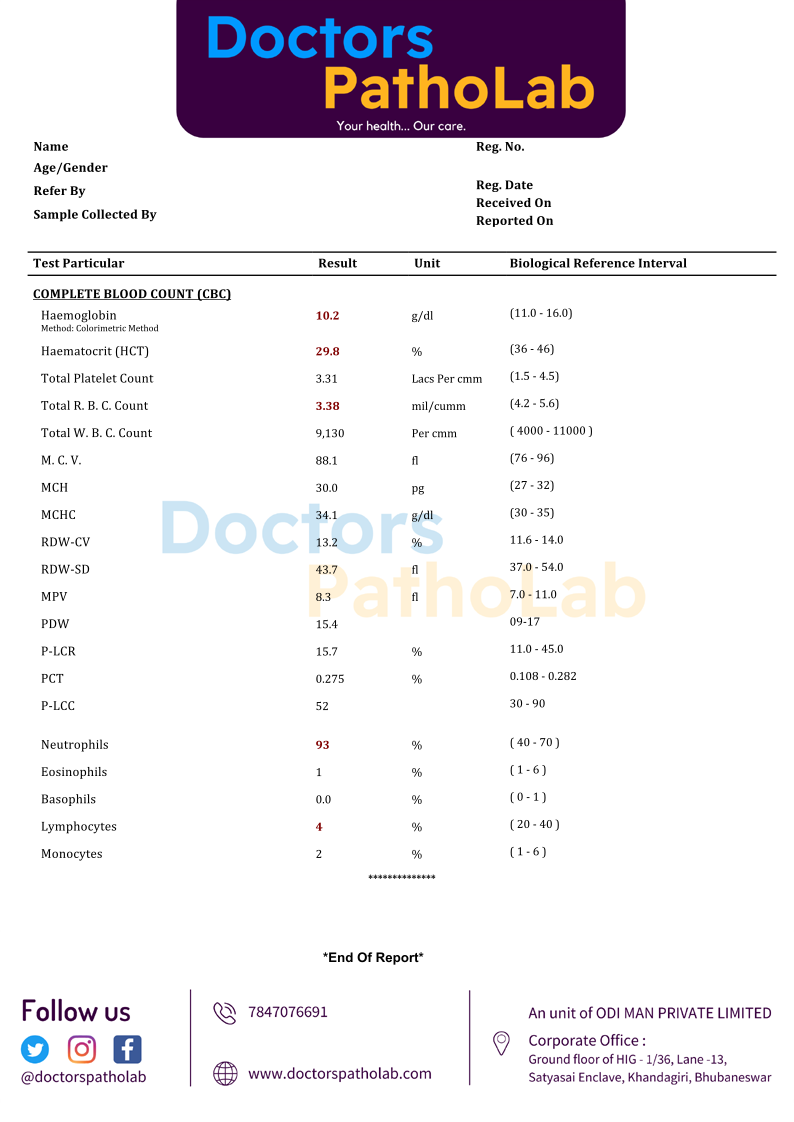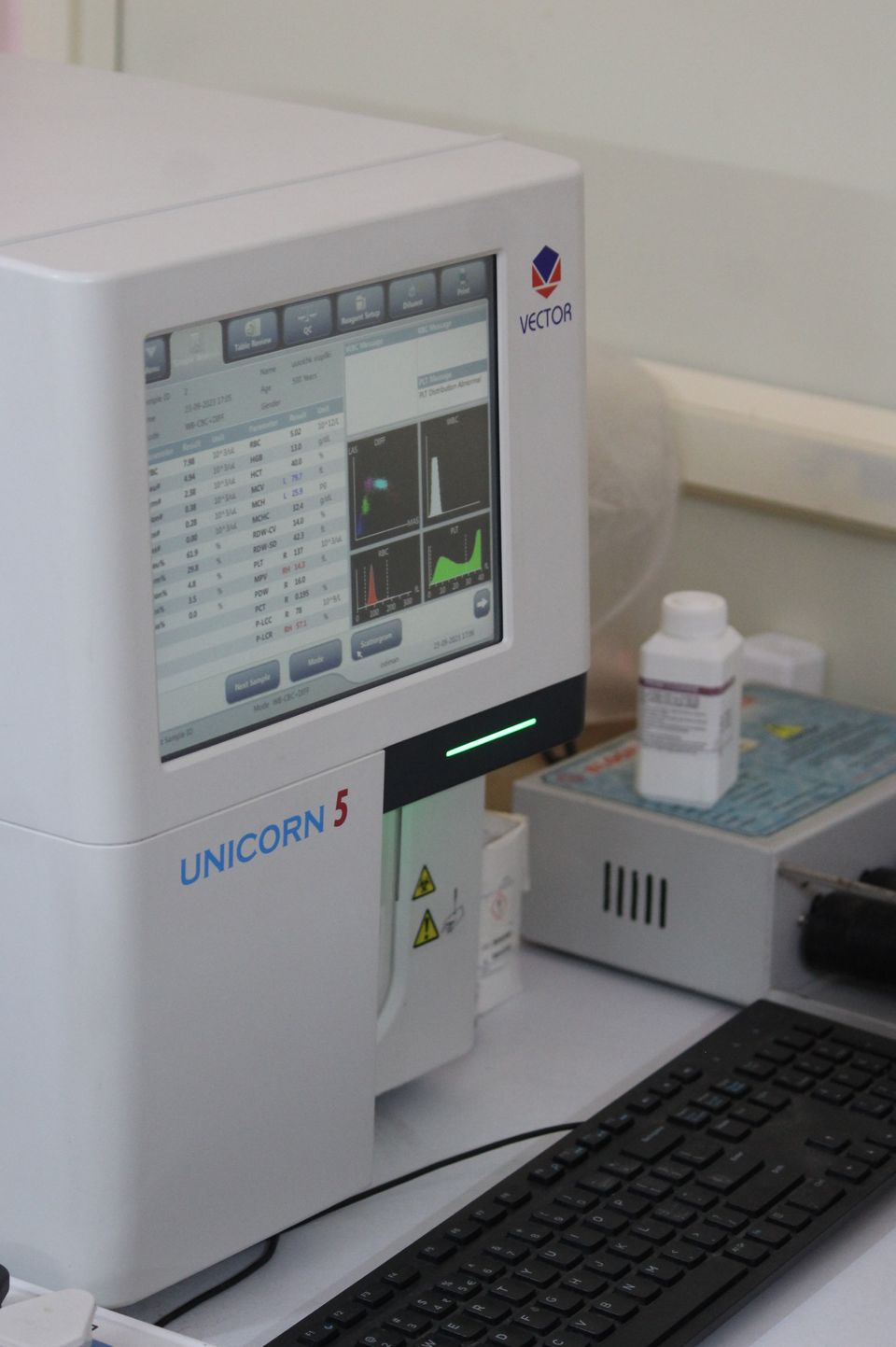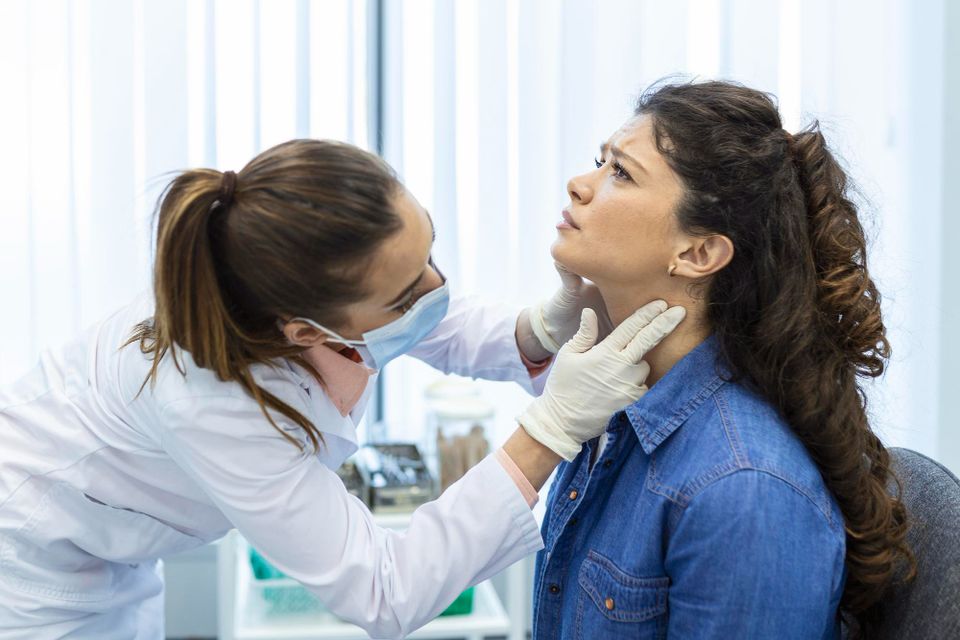All about CBC tests parameters!

The complete blood count (CBC) measures many important values related to the blood cells. The complete blood count interpretation is done by doctors who review the results of the testing.
Above you can see a sample report of a Complete Blood Count test.
The complete blood count generally includes the following components:
- Leukocyte count (White Blood Cells - WBC)
- WBC Differential Count
- Red Blood Cell count (RBC or Erythrocyte Count)
- Hematocrit (Hct)
- Hemoglobin (Hgb)
- Mean Corpuscular Volume (MCV)
- Mean Corpuscular Hemoglobin (MCH)
- Mean Corpuscular Hemoglobin Concentration (MCHC)
- Red Cell Distribution Width (RDW)
- Platelet Count
There are many other advanced parameters in a report like our 24 parameter CBC tests done in our 5 part CBC machine. Learn more about machine differences here.
You can always call us for any queries and test bookings. You can also fill the form at the end if you want to recieve a call back form our side.
The following lists some of the typical values of the components of the complete blood count:
- WBC (white blood cell) count signifies the number of white blood cells in the blood and usually ranges between 4,300 to 10,800 cmm (cells per cubic millimeter).
- RBC (red blood cell) count measures the number of red blood cells in a volume of blood and usually ranges between 4.2 to 5.9 million ccm (cells per cmm.)
- Hemoglobin (Hbg) measures the amount of the hemoglobin molecule in a volume of blood and normally is 13.8 to 17.2 g/dL (grams per deciliter) for men and 12.1 to 15.1 g/dL for women.
- Hematocrit (Hct) signifies the percentage of the whole blood occupied by red blood cells and usually ranges between 45%-52% for men and 37%-48% for women.
- Mean corpuscular volume (MCV) is the measurement of the average size or volume of a typical red blood cell in a blood sample and usually ranges between 80 to 100 femtoliters (a fraction of one-millionth of a liter
- Mean corpuscular hemoglobin (MCH) measures the amount of hemoglobin in an average red blood cell and usually ranges between 27 to 32 picograms (1 picogram = 1/10,00,00,00,00,000 grams "Its 12 zeros!").
- Mean corpuscular hemoglobin concentration (MCHC) measures the average hemoglobin concentration in a volume of blood, and it usually ranges between 32%-36%.
- Red cell distribution width (RDW) measures the variability in the red blood cells' size and shape and usually ranges between 11 to 15.
- Platelet count measures the number of platelets in a volume of blood and usually ranges between 150,000 to 400,000 per cmm.
- Mean platelet volume (MPV) measures the average size of platelets in a volume of blood. The normal range is between 6 to 12 femtoliters (1 femtoliter = 1/1,00,00,00,00,00,00,000 liters. "Its 15 zeros...").
What Is a Function of Cells in a Complete Blood Count?
The cells in a complete blood count serve very important functions in the body.
The White blood cells are an important component of the immune system which fights against infections in the body. They are made in the bone marrow and undergo a complex series of steps to gain functional maturity at which time they are released into the bloodstream to perform their function.
An elevated WBC count typically indicates some kind of infection or inflammation in the body. Each of the cells in the WBC differential also has specific functions that are important to note when analyzing the results of a complete blood count. For example, Eosinophils may be involved in allergic reactions. Neutrophils are usually more suggestive of a bacterial infection whereas lymphocytes typically suggest a viral infection. An elevation of the WBC count or an abnormality of the WBC differential may be suggestive of an infection or inflammation. A high or a low WBC count could also be a sign of underlying cancer such as leukemia or lymphoma.
Red blood cells are a vital part of the oxygen transport system in the body. The Hemoglobin molecule is a complex protein structure that exists within the Red blood cells and is the physical carrier of oxygen from the lungs to all other parts of the body. Decreases in the Red blood cell count or the hemoglobin level may interfere with the oxygen carrying capacity of the red blood cells. A low RBC or Hemoglobin count typically indicates anemia (low blood). Anemia, typically seen as low hemoglobin or low hematocrit on the CBC, is a sign of an underlying disease and it is not a disease itself. Anemia can have many causes including blood loss, bone marrow problems, nutritional deficiencies, genetic hemoglobin structural or functional problems (sickle cell or thalassemia), or kidney failure. These are only the most common causes of anemia, and the list of all causes of anemia is very extensive. Anemia found in a CBC may be suggestive of ongoing slow blood loss and, therefore, can be used to detect cancers, such as colon cancer. If anemia is detected, usually the MCV and RDW give some additional clues as to the possible causes of anemia.
Platelets are an important part of the blood clotting system. They are not complete cells, but fragments of larger cells called megakaryocytes. Platelets become activated when there is any evidence of bleeding or injury somewhere in the body. They clump together at the site of bleeding (called platelet aggregation) in an attempt to plug up the bleeding site. This is done in concert with other components of the clotting system which includes some specific proteins such as thrombin.
A low platelet count (thrombocytopenia) may also be detected in the CBC. This may be due to bone marrow problems, some medications or excessive alcohol use. Sometimes(More like rarely) it is just immunologic, genetic problems, advanced liver disease, or cancers such as leukemia.
The MPV may indicate how rapidly platelets are made in the bone marrow and released into the bloodstream. The MPV may indicate how rapidly platelets are made in the bone marrow and released into the bloodstream.
Remember to always consult a medical practitioner before jumping on to any health related conclusion. These types of articles are made so that you as a consumer get to know more about the tests that you get done. They are not any kind of medical advice.
Incase you have done the tests without any medical reference and find the readings not optimal, you can always contact us to book a appointment with our in house available doctors.




